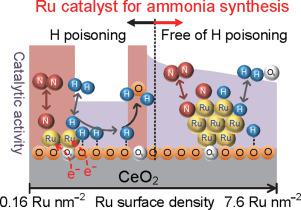Chinese Journal of Catalysis ( IF 16.5 ) Pub Date : 2021-06-22 , DOI: 10.1016/s1872-2067(20)63787-1 Bingyu Lin , Yuyuan Wu , Biyun Fang , Chunyan Li , Jun Ni , Xiuyun Wang , Jianxin Lin , Lilong Jiang

|
Evaluating the effect of metal surface density on catalytic performance is critical for designing high-activity metal-based catalysts. In this study, a series of ceria (CeO2)-supported Ru catalysts (Ru/CeO2) were prepared to analyze the effect of Ru surface density on the catalytic performance of Ru/CeO2 for ammonia synthesis. For the Ru/CeO2 catalysts with Ru surface densities lower than 0.68 Ru nm−2, the Ru layers were in close contact with CeO2, and electrons were transferred directly from the CeO2 defect sites to the Ru species. In such cases, the adsorption of hydrogen species on the Ru sites in the vicinity of O atoms was high, leading to a high ammonia synthesis activity and strong hydrogen poisoning. In contrast, the preferential aggregation of Ru species into large particles on top of the Ru overlayer resulted in the coexistence of Ru clusters and particles, for catalysts with a Ru surface density higher than 1.4 Ru nm−2, for which Ru particles were isolated from the direct electronic influence of CeO2. Consequently, the Ru−CeO2 interactions were weak, and hydrogen poisoning can be significantly alleviated. Overall, electron transfer and hydrogen adsorption synergistically affected the synthesis of ammonia over Ru/CeO2 catalysts, and catalyst samples with a Ru surface density lower than 0.31 Ru nm−2 or exactly 2.1 Ru nm−2 exhibited high catalytic activity for ammonia synthesis.
中文翻译:

Ru表面密度对氧化铈负载Ru催化剂氨合成活性和氢中毒的影响
评估金属表面密度对催化性能的影响对于设计高活性金属基催化剂至关重要。在本研究中,制备了一系列氧化铈 (CeO 2 ) 负载的 Ru 催化剂 (Ru/CeO 2 ),以分析 Ru 表面密度对 Ru/CeO 2合成氨的催化性能的影响。对于Ru表面密度低于0.68 Ru nm -2的Ru/CeO 2催化剂,Ru层与CeO 2紧密接触,电子直接从CeO 2转移Ru 物种的缺陷位点。在这种情况下,O 原子附近的 Ru 位点上的氢物质吸附量高,导致氨合成活性高,氢中毒严重。相比之下,对于 Ru 表面密度高于 1.4 Ru nm -2 的催化剂,Ru 物质优先聚集成 Ru 覆盖层顶部的大颗粒导致 Ru 簇和颗粒共存,为此,Ru 颗粒从CeO 2的直接电子影响。因此,Ru-CeO 2相互作用较弱,可以显着减轻氢中毒。总体而言,电子转移和氢吸附协同影响了 Ru/CeO 2上氨的合成催化剂,并且具有低于 0.31 Ru nm -2或恰好 2.1 Ru nm -2的 Ru 表面密度的催化剂样品表现出对氨合成的高催化活性。



























 京公网安备 11010802027423号
京公网安备 11010802027423号